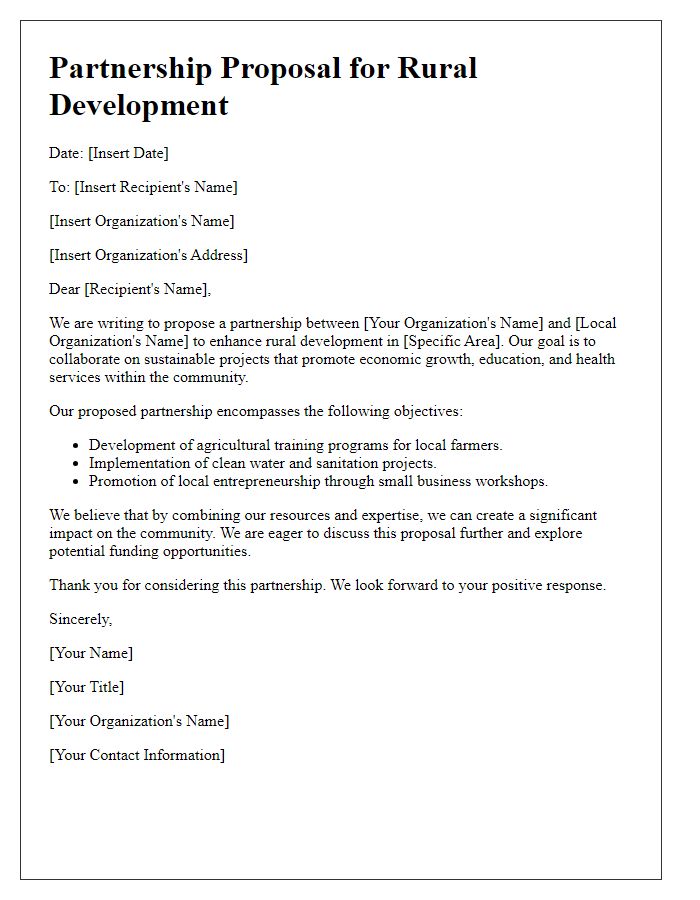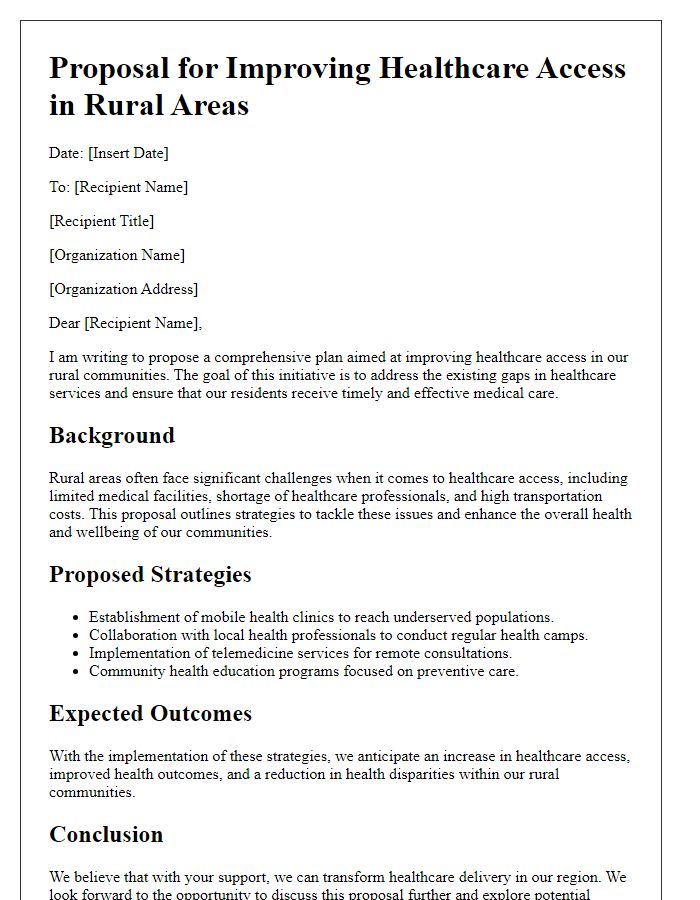Are you passionate about making a difference in rural communities? In this article, we explore a comprehensive proposal template designed specifically for rural development initiatives. Whether you're looking to improve infrastructure, enhance education, or boost economic opportunities, our template provides a structured approach to present your ideas effectively. Dive in to discover how you can create impactful change and be sure to read more for valuable tips and insights!

Project Overview
The Rural Development Project aims to enhance agricultural productivity, improve access to clean water, and promote sustainable practices within the agricultural communities of the Midwest region of the United States. This initiative will be implemented in counties such as Johnson and Greene, targeting approximately 1,500 local farmers. The project will focus on introducing advanced irrigation techniques, like drip irrigation that offers water conservation benefits, and organic farming methods that improve soil health. Training workshops will be organized, where expertise from agricultural scientists and experienced farmers will be shared, ensuring capacity building and knowledge transfer. Funding of $500,000 is being sought to support infrastructure development, including the installation of solar-powered water pumps, and the development of community gardens that will serve both as a resource and a source of fresh produce for local markets. Additionally, partnerships with non-profit organizations will be established to create a comprehensive support network for the farmers involved in the project.
Community Needs Assessment
The Community Needs Assessment (CNA) serves as a critical tool in identifying specific needs within rural areas, focusing on factors such as socioeconomic status, education levels, and health care accessibility. In regions like the Appalachian Mountains, where poverty rates can exceed 25%, understanding local demographics is essential for effective intervention. Infrastructure issues, including lack of access to clean water and reliable transportation, often hinder growth. Community meetings, surveys, and interviews can provide insight into residents' priorities. Data analysis from sources such as the U.S. Census Bureau enhances understanding of the population's needs, ensuring that proposed developments address real challenges faced by communities. Prioritizing projects that improve education, healthcare, and economic opportunities can lead to sustainable growth in these underserved areas.
Objectives and Goals
Rural development initiatives aim to enhance the quality of life for residents in rural areas, targeting improvements in essential services, economic opportunities, and community engagement. Objectives include increasing access to quality education, with a focus on the implementation of mobile learning units in underserved villages like Lonesome Creek, which has a population of approximately 1,500. Goals involve boosting local agriculture by introducing sustainable farming techniques to over 300 farmers, enhancing production yields by 20% within two years. Furthermore, the initiative seeks to establish microfinance programs for women entrepreneurs in rural regions, aiming to empower at least 200 women by providing small loans to support their small businesses. Additionally, improving infrastructure, such as building 50 kilometers of new roads, will enhance accessibility to markets and healthcare facilities, ultimately fostering economic growth and community resilience.
Budget and Funding Sources
The budget for the rural development proposal focuses on critical areas such as infrastructure improvement, agricultural support, and community programs. The projected budget totals $250,000, with breakdowns including $100,000 for road construction in underserved areas, $75,000 designated for sustainable farming initiatives, and $50,000 for educational workshops on health and wellness. Funding sources comprise local government support, anticipated grants from non-profit organizations like the Rural Advancement Foundation, and contributions from community fundraising events. Collaboration with local businesses, promoting economic partnerships, will also play a crucial role in augmenting financial resources for the project's long-term sustainability.
Implementation Timeline
Rural development initiatives often require clear implementation timelines to ensure effective execution and monitoring. The proposed project, aimed at enhancing agricultural productivity and improving access to clean water in regions such as the Sundarbans in India, features a detailed twelve-month implementation timeline. Month one involves community engagement workshops, where at least 100 local stakeholders will discuss project goals and gather feedback. By month three, baseline surveys will be conducted, assessing soil health across 50 farms. Months four to six focus on the installation of irrigation systems, utilizing a budget of $20,000, complemented by volunteer labor from the community. Training sessions for local farmers on sustainable agricultural practices will occur in month seven, reaching over 200 participants. Months eight and nine aim to establish two clean water wells, estimated to benefit 500 residents in remote villages. The final months will concentrate on evaluation and reporting, ensuring all stakeholders receive comprehensive data about project impacts and outcomes, thereby fostering transparency and community trust.
Letter Template For Rural Development Proposal Samples
Letter template of rural development project proposal for community engagement.

Letter template of rural development funding proposal for infrastructure improvement.

Letter template of rural development initiative proposal focusing on sustainable agriculture.

Letter template of rural development partnership proposal with local organizations.

Letter template of rural development proposal addressing education and literacy.

Letter template of rural development proposal for improving healthcare access.

Letter template of rural development proposal for renewable energy solutions.

Letter template of rural development proposal promoting women's empowerment.






Comments